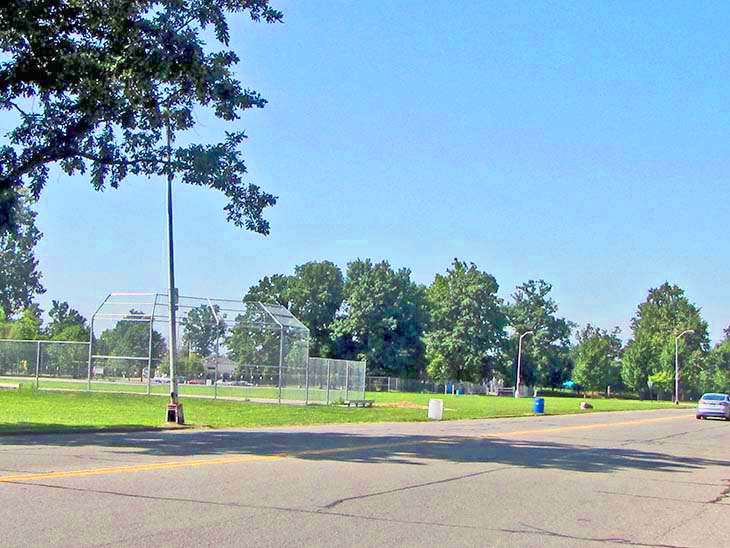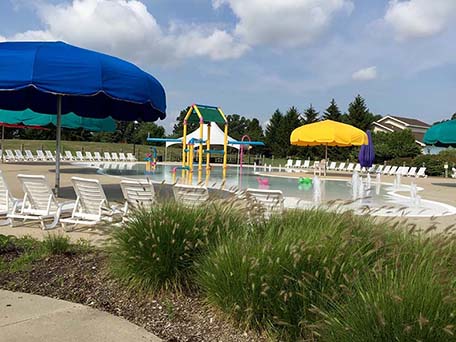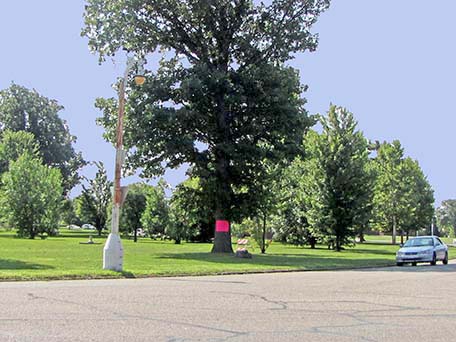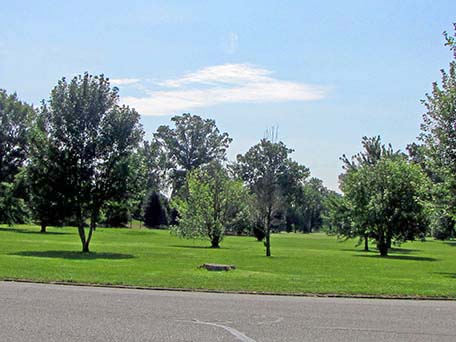

This large park (201 acres) is located on the east side of Detroit. The land was a component of Grosse Pointe Township until it was annexed by the city of Detroit in 1917. I believe that some of the area had been used by Grosse Pointe as a park. Because the rapidly growing vehicle industry generated substantial revenues for the city, Detroit was very financially secure in the later teen years of the last century. In 1919, the city decided to massively develop the park system. Thanks to that World War I era decision, Detroit could—with some substantial investments—have the nation’s finest municipals parks. Belle Isle (983 acres) had been a park since the 1870s and Palmer Park (296 acres) had been given to the city by Thomas W. Palmer in the early years of the last century. The city of Detroit, in 1920, paid six farmers $1.3 million for the land for Rouge Park which is the city’s largest (1182 acres). This Chandler Park was targeted for development by a city at a time when resources were available. Shortly after 1920, the city laid out a substantial and challenging golf course, built a pool or pools for swimming and acres of green space. In 1926, the park was named for one of the city’s most powerful and accomplished Nineteenth Century politicians, Zachariah Chandler. He was also, arguably, Detroit’s most famous abolitionist.
I believe that only modest investments were made in Chandler Park after the start of the Depression. When the city’s youthful population was growing rapidly after World War II, there was discussion of building a school within the park but that did not happen. After the 1960s, the city’s financial difficulties precluded major investments in any of Detroit array of 308 parks and play grounds. Wayne County built a large and impressive Aquatic Center within the park; one that opened in 1998 and is very well maintained by the county.
The redevelopment of Detroit following bankruptcy is most evident in downtown, Midtown and the east Riverfront. But many positive devel opments occurred in less visited areas of the city. In 2015, long-term and former residents of Detroit announced a $20 million dollar plan to renovate the huge Chandler Park. These plans are very carefully and thoroughly described on their website whose URL is listed below. There will be wetlands, tennis courts and new fields for soccer, football, softball and baseball. In addition, this endeavor foresees establishing a new charter school within the park to be called the Lighthouse Academy with an enrollment of 800 students. It will specialize in offering training about ecological issues and its students will be responsible for water management within the park and the to-be-established wetlands. When the announcement was made, about one-half of the funding had been raised from sources, including Fiat-Chrysler America, the Kellogg Foundation, the Kresge Foundation, the United Auto Workers, the U.S. Soccer Foundation, the Matilda Wilson Foundation and the Ralph C. Wilson Foundation. This could be a major development leading to the stabilization of the nearby Chandler Park neighborhood and, perhaps, to the Morningside and East English Village communities.
opments occurred in less visited areas of the city. In 2015, long-term and former residents of Detroit announced a $20 million dollar plan to renovate the huge Chandler Park. These plans are very carefully and thoroughly described on their website whose URL is listed below. There will be wetlands, tennis courts and new fields for soccer, football, softball and baseball. In addition, this endeavor foresees establishing a new charter school within the park to be called the Lighthouse Academy with an enrollment of 800 students. It will specialize in offering training about ecological issues and its students will be responsible for water management within the park and the to-be-established wetlands. When the announcement was made, about one-half of the funding had been raised from sources, including Fiat-Chrysler America, the Kellogg Foundation, the Kresge Foundation, the United Auto Workers, the U.S. Soccer Foundation, the Matilda Wilson Foundation and the Ralph C. Wilson Foundation. This could be a major development leading to the stabilization of the nearby Chandler Park neighborhood and, perhaps, to the Morningside and East English Village communities.
The park is named after Detroit’s most famous abolitionist. Zachariah Chandler was born in 1813 into a prosperous and well-establish New Hampshire family. Apparently, when he reached age 20, his parents gave his a choice of college tuition or $20,000. Chandler took the money and migrated, at that young age, to the growing city of Detroit. He opened a business that was very successful. Quickly he moved on to land speculation, wholesale trade and banking. By the 1840s, he ranked among the richest men in the new state of Michigan.
Most northern politicians in the pre-Civil War era took a stand on slavery. Some were ardent abolitionist meaning that they stressed the need to immediately end bondage in this county. A few defended slavery while other sought a middle course that might gradually reduce slavery in the country to send many or all African Americans to the Caribbean or Africa. Chandler was an unambiguous and dedicated abolitionist. He campaigned for Zachary Taylor in the 1848 election and then ran for  mayor of Detroit in 1851. He was victorious but the next year he sought the governor’s office but lost the election to _____. Immediately thereafter, he became one of the founders of the Republican Party assuming, I infer, that a major new party was needed to end slavery in the United States.
mayor of Detroit in 1851. He was victorious but the next year he sought the governor’s office but lost the election to _____. Immediately thereafter, he became one of the founders of the Republican Party assuming, I infer, that a major new party was needed to end slavery in the United States.
In 1857, the state legislature selected Zachariah Chandler to represent Michigan in the United States Senate, a post he held for twenty years. He was a consistent advocate for abolishing slavery. After President Lincoln signed the Emancipation Proclamation and after General Grant forced General Lee to surrender at Appomattox, questions arose about what rights did the former slaves have and what duty, if any, did the federal government have to protect those rights. Chandler was an out spoken and consistent Radical Republican. That is, he strongly supported the various constitutional amendments and Civil Rights Acts that the Republicans passed in the years after the Civil War. Ulysses S. Grant was elected president in 1868 and he took a unambiguous stand for voting rights for former slaves and, against the wishes of many elected officials, held that the U. S. military should be used in the South to put down the Ku Klux Klan and various hate groups that initiated violence against Blacks or forcefully prevented them from voting. Grant was also known for the very liberal stand he took regarding the treatment of Indians at a time when using the military to confine Indians to reservations was quite popular.
What does all this verbiage about Grant have to do with Chandler? Ulysses Grant is the only president who lived in Detroit for several years. He was posted to Fort Wayne in the late 1840s and early 1850s. At that time, Zachariah Chandler had a home in downtown Detroit commensurate with his status. During the winter of 1850-51, Grant and fellow officers, who lived nearby, apparently often slipped and fell when walking on the sidewalk in from of Chandler’s home. They decided to haul Chandler into court for violating a city ordinance that requiring home owners to shovel snow on their sidewalks. The prosecutor reluctantly agreed to bring charges. Before the matter came before a judge, Chandler was nominated to run for mayor. Apparently, being one of the richest and most prominent men in the city, Chandler was upset by the charges against him. All of the officers except Grant exempted themselves from the litigation. Perhaps they were intimidated to testify against the most powerful man in Detroit. When the court heard the charges, Chandler, in his own defense stated that “If you soldiers would keep sober, perhaps you would not fall on people’s pavements and hurt your legs.”
Grant has often and erroneously been portrayed as a man who consumed too many spirituous drinks. Perhaps that derogatory stereotype had its origin in what Chand ler contended in his trail. The court found Chandler guilty of not shoveling his sidewalk but the judge made his feeling known by fining him a total of six cents.
ler contended in his trail. The court found Chandler guilty of not shoveling his sidewalk but the judge made his feeling known by fining him a total of six cents.
Grant did not hold grudges. Columbus Delano served as Secretary of the Interior in Grant’s second administration. The department supervised Indian affairs. Observers began to describe a great deal of exploitation of Indians and denial of their rights as railroads crisscrossed the nation. Isolated tribal lands became valuable for farming and mining. In addition, the Bureau of Indian Affairs ran trading post and there were numerous accusations of unethical practices that further impoverished Native Americans, including some linked to Delano’s son. Delano was not shown to be directly responsible for these matters but they occurred in his department so President Grant fired him in the summer of 1875. Then, he selected Michigan Senator Zachariah Chandler to head the Department of the Interior. Chandler immediately instituted reforms to prevent the further exploitation of Native Americans.
There is no historical marker in this increasingly attractive park to honor man who was, perhaps, the city’s most persistent abolitionist and civil rights advocate of his era. I hope the Chandler Park Conservancy will consider erecting such a marker.
Architect for the design of the park: Unknown to me
Use in 2017: Urban park
Website for Chandler Park Conservancy: http://www.chandlerparkconservancy.org/
Information about Chandler and President Grant: Ronald C. White, American Ulysses: A Life of Ulysses S. Grant, New York: Random House, 2016.
City of Detroit Designated Historic District: Not listed
State of Michigan Registry of Historic Sites: Not listed
National Register of Historic Places: Not listed
Photograph: Ren Farley
Description prepared: February, 2017
Return to Parks and Recreation
Return to Homepage